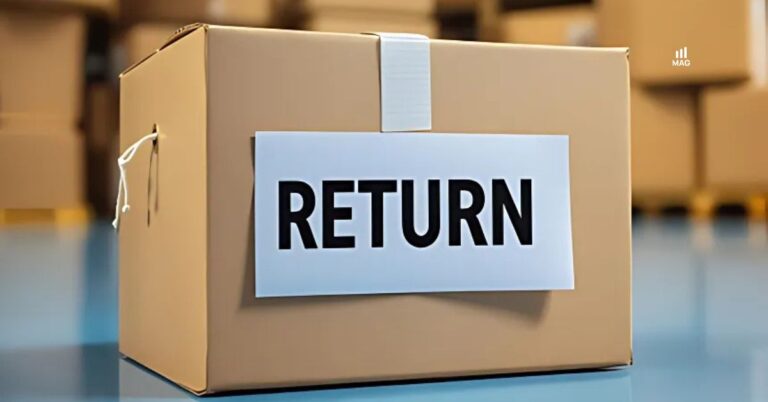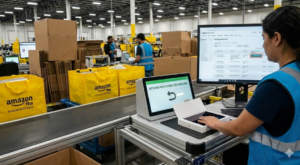
Amazon returns are fueling rising fraud, crushing seller margins, and sending millions of products straight to landfills, exposing the true cost behind convenience.
For many Amazon sellers, a sale isn’t final until the return window closes. While Amazon’s overall return rate of 5-15% outperforms the broader e-commerce average, this figure masks a painful reality in high-volume categories like apparel and electronics, where returns can surge to 30% or more.
Each return eats directly into your profit margins through shipping costs, unsellable used goods, and Amazon’s new return processing fees. This constant financial drain is made worse by rising return fraud, where sellers are left with lost products and even less recourse.
It’s a costly and frustrating cycle that makes managing cash flow and inventory a significant challenge. Protecting your business requires a proactive approach.
By understanding the real drivers behind your returns, optimizing your listings for clarity, and implementing stricter internal controls, you can begin to reduce your return rate. Exploring strategies beyond FBA and leveraging data can help you turn a major liability into a manageable part of your operations.
Seller burdens rise as return rates and fraud intensify
My Amazon Guy, Amazon Agency"High return rates can negatively affect seller account health metrics like Order Defect Rate (ODR) and customer feedback, potentially leading to account suspensions."
A recent CNBC report highlights the growing challenges that third-party sellers face with Amazon’s return policies, which are often described as risky and expensive for small businesses. The ease of returns for shoppers has created a system where some sellers are considering exiting the popular Fulfillment by Amazon (FBA) program or leaving the platform entirely.
A significant part of the problem is the sharp increase in return fraud, which harms both sellers and consumers. In some egregious cases, returned and used products, including soiled baby items and contaminated chillers, were mistakenly reshipped to new customers. This trend reflects a broader issue, with the National Retail Federation noting that fraudulent returns cost retailers nearly $900 billion in 2024.
To address high return volumes, Amazon has taken several steps that affect sellers directly. These measures include:
- New Return Fees: In June 2024, Amazon introduced a new fee for sellers in the FBA program whose products exceed specific return rate thresholds for their category.
- Warning Labels: The platform has also started adding a “frequently returned item” warning label on certain product listings to inform customers before they purchase.
While these actions led to a nearly 5% drop in return rates shortly after implementation, they have also had other consequences. A survey by SmartScout revealed that 65% of sellers raised their prices in 2024 specifically because of Amazon’s fee changes.
Others have increased prices to offset the growing costs associated with fraudulent returns. The financial strain is significant, with some sellers reporting that return abuse has reduced their net profit margins on Amazon to as low as 1%.
Sellers also point to higher return rates on Amazon compared to other marketplaces like Walmart and eBay. Unlike other platforms, Amazon does not allow sellers to block customers who have a history of fraudulent activity.
In response, some sellers are investing in their own security measures, such as installing extensive camera systems to document outgoing items and incoming returns for appeals. Amazon has made some improvements, such as allowing multiple appeals for fraudulent returns and letting sellers of higher-value items opt out of automatic return labels.
However, the core issues continue to drive some merchants, like the founder of Ceres Chill, to leave the Fulfillment by Amazon (FBA) program to protect their brand’s reputation and ensure customer safety.
Sellers feel the squeeze from organized return fraud
According to an analysis by PYMNTS, Amazon’s return policies have become a significant point of frustration for many of the platform’s third-party sellers. The challenges have led some merchants to withdraw from the FBA program, while others are reportedly considering leaving the e-commerce site altogether.
A primary driver of this issue is a dramatic spike in returns fraud. This has resulted in damaging incidents where customers who ordered new products mistakenly received used or even soiled items that had been previously returned.
The financial and operational impacts are substantial. Key data points on this trend include:
- Fraud Rate Growth: Fraudulent returns have surged, accounting for nearly 14% of all retail returns last year, a sharp increase from just 5% in 2018.
- Total Retail Loss: A report from the National Retail Federation (NRF) found that returns cost retailers a total of $890 billion last year.
- Seller Price Hikes: In response to new return fees implemented by Amazon, one survey found that 65% of sellers raised their prices to offset the added costs.
The problem is evolving beyond individual bad actors into a more organized threat. Criminal enterprises now advertise “refund fraud as a service” on social media platforms like Telegram, TikTok, and Instagram. These groups actively teach dishonest consumers tactics and strategies to successfully commit and get away with fraudulent returns.
In response, Amazon states it has no tolerance for this activity and takes action against scammers. These measures include denying refunds to fraudulent actors and requiring more stringent customer identity verification.
rm dominance.
The environmental cost of convenient returns
Based on reporting from TheCoolDown, the ease of free online returns is creating a massive and often overlooked environmental problem. The sheer volume is staggering, with an estimated 3.5 billion products returned annually in the United States alone, many of which end up in landfills.
Each returned product carries a significant carbon footprint from manufacturing and multi-stage shipping. Many of these items travel thousands of miles only to be discarded, where they can release methane or, in the case of electronics, leak toxic chemicals into the soil and water.
The issue is made worse by the economics of reverse logistics. For many retailers, it is simply cheaper to dispose of a returned item than to invest the labor and resources required to inspect, reprocess, and restock it.
While Amazon has public sustainability goals, including its Climate Pledge to reach net-zero carbon by 2040, critics argue its business model encourages the high consumption that leads to waste. The problem of return waste, in particular, remains a significant challenge, though some Amazon facilities do work with liquidation and donation programs.
Consumers can take several steps to help reduce this waste. Key actions include:
- Buying with Intention: Thoroughly research products, read reviews, and check sizing charts carefully to reduce the likelihood of a return.
- Considering Alternatives: Before returning an item, consider if it can be repaired, gifted, or donated locally.
- Shopping Smarter: Whenever possible, shop at local stores to see products firsthand or choose online retailers with transparent and responsible return policies.
Giving Compass"Often, returned products simply end up in landfills, sometimes overseas. In 2019, about 5 billion pounds of waste from returns were sent to landfills, according to an estimate by the return technology platform Optoro."






